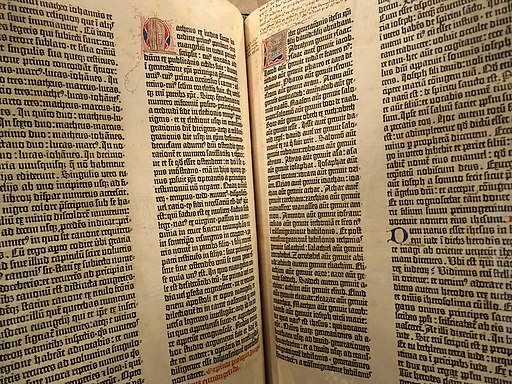
The Gutenberg Bible was among the earliest books and the first Bible printed using mass-produced movable metal type in Europe. This book, published in the 1450s, is valued for its aesthetic and artistic qualities, as well as its historical significance.
Forty-nine copies have survived and are among the world’s most valuable books. Less than 185 copies were printed with about three-quarters on paper and the others on vellum.
The Gutenberg Bible contains the Latin version of the Hebrew Old Testament and the Greek New Testament. Most were sold to monasteries, universities, and wealthy individuals.
The Bible seems to have sold out immediately, with a price of at least three years’ wages for a clerk. Although this made them significantly cheaper than manuscript Bibles, most people of ordinary income wouldn’t have been able to afford them.
The Gutenberg Bible had a profound effect on the history of the printed book and influenced future editions of the Bible.
Of the 49 Gutenberg Bibles known to exist today, only 21 are complete. Others have pages or whole volumes missing. Twelve copies on vellum survive, although only four of these are complete.
Today, few copies remain in religious institutions, with most now owned by universities, libraries, and other major academic institutions.
The first Gutenberg Bible reached North America in 1847 and is now in the New York Public Library.

Gutenberg Bible of the New York Public Library bought in 1847; it was the first copy to be acquired by a United States citizen.
The only copy held outside Europe or North America is the first volume of a Gutenberg Bible at Keio University in Tokyo.
The last sale of a complete Gutenberg Bible took place in 1978, which sold for $2.2 million. This copy is now in Austin, Texas.
A two-volume paper edition of the Gutenberg Bible at the Moscow State University was estimated to be worth more than $20 million.
The Gutenberg printing press
Around 1450, Johannes Gutenberg introduced the first movable type printing system in Europe. He advanced innovations in casting the type.
He introduced adaptations to the screw-press, the use of an oil-based ink, and the creation of a softer and more absorbent paper.
Gutenberg was the first to create his type pieces from an alloy that is still used today.
Compared to woodblock printing, movable type page setting and print using a press was faster and more durable.
Also, the metal type pieces were sturdier and the lettering more uniform, leading to typography and fonts.
The high quality and relatively low price of the Gutenberg Bible established the superiority of movable type for Western languages.
The printing press rapidly spread across Europe, and the “Gutenberg Revolution” played a crucial role in the development of the Renaissance, the Reformation, the Age of Enlightenment, and the scientific revolution.

Gutenberg Bible (c. 1455) – New York Public Library
Johannes Gutenberg
Johannes Gutenberg (1400 – 1468) was a German goldsmith, inventor, printer, and publisher who introduced printing to Europe with the printing press.
His introduction of mechanical movable type printing to Europe started the Printing Revolution.
The arrival of mechanical movable type printing introduced the era of mass communication, which permanently altered the structure of society.
His major work, the Gutenberg Bible was the first printed version of the Bible and has been acclaimed for its high aesthetic and quality.
Gutenberg Bible
- Title: Gutenberg Bible
- Also: 42-line Bible, the Mazarin Bible or the B42
- Date: 1450
- Culture: German
- Writing: Latin
- Material: Paper and vellum
- Type: Ancient Texts
- Museum: British Library, Vatican Library, New York Public Library
The Book That Changed the World
1455: Gutenberg Bible published
Virtual Tour of the British Library
- Theatrum Orbis Terrarum
- Constitution of the Athenians by Aristotle
- “Newton after Blake” by Eduardo Paolozzi
- The Beowulf Manuscript – Nowell Codex
- Lindisfarne Gospels
- Gutenberg Bible
Gutenberg Bible: A Virtual Tour
Virtual Tour of Ancient Texts
- Gilgamesh Flood Tablet – 7th century BCE
- Lament for Ur – 1800 BC
- Law Code of Hammurabi – 1754 BC
- Book of the Dead – Papyrus of Ani and Hunefe – 1250 BCE
- Cyrus Cylinder – 539–538 BC
- The Rosetta Stone – 196 BC
- Constitution of the Athenians by Aristotle – 100
- Vindolanda Tablets – 1st-century
- Codex Vaticanus – 300–325
- Vienna Dioscurides – Juliana Anicia Codex – 515
- Lindisfarne Gospels – 715-720
- Beowulf – Nowell Codex – 975–1025
- Blue Qur’an – 9th – 10th century
- Miroslav Gospel – 1186
- Hadith Bayad wa Riyad – 13th-century
- The Belles Heures of Jean of France, Duke of Berry – 1405
The Story of the Gutenberg Bible
Gutenberg Printing Press
Virtual Tour of Historically Influential Books
- Gutenberg Bible – 1450
- Code Noir – 1687
- “Common Sense” by Thomas Paine – 1766
- “Poems on Various Subjects, Religious and Moral” by Phillis Wheatley – 1766
- Gardner’s Photographic Sketchbook of the Civil War – 1863
- Ancient Texts and Historically Influential Books
The Gutenberg Bible
How a Gutenberg printing press works
~~~
“Give me twenty-six soldiers of lead, and I will conquer the world.”
– Johannes Gutenberg
~~~
Photo Credit: 1) Johannes Gutenberg / Public domain; NYC Wanderer (Kevin Eng) / CC BY-SA (creativecommons.org/licenses/by-sa/2.0); Adam Jones from Kelowna, BC, Canada / CC BY-SA (creativecommons.org/licenses/by-sa/2.0)
Popular this Week








 Sponsor your Favorite Page
Sponsor your Favorite Page SEARCH Search for: Search Follow UsJoin – The JOM Membership Program
Sponsor a Masterpiece with YOUR NAME CHOICE for $5
Share this:
- Tweet
